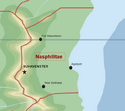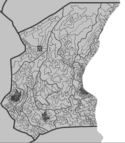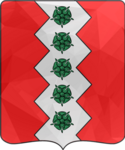Nasphilitae (Pacifica)
Grand Duchy of Nasphilitae | |
|---|---|
Motto: "Beauty is Joy is Wisdom is Sentiment is Truth" | |
 Physical Map of Nasphilitae | |
 Political Map of Nasphilitae | |
| Location | Southwest of the Crabry continent |
| Capital | Suhavenster |
| Largest city | Agorport |
| Official languages | Austral |
| Recognised regional languages | Alman, Montacian, Friean, Cimbrian, Aegean, Kotomoto, Pelinese Hinomoto, Gara, Karnetvorian, Sedunnic |
| Demonym(s) | Nasphiliti |
| Government | Regional Electoral Monarchy Democracy |
| Dawson Ernst | |
| Syd G. Patton | |
| Nowell Riley Trenton | |
| Claire Renske | |
| Legislature | The National Parliament |
| The Upper House of Localities | |
| The Lower House of Country Collective | |
| Establishment | |
• Act of Settlement | 1589 |
• Ordinance of Unifying Colonies | December 15. 1661 |
• Home Rule Act & Dominion Status | November 10. 1662 |
• Acts of Electoral Peerage & Grand Duchy Status | May 20. 1852 |
• Royal Grant of Independence from the Austral Empire | December 25. 1952 |
| Area | |
• Total | 75,704 km2 (29,229 sq mi) (19) |
| Population | |
• 2024. census | 17,775,000 |
• Density | 234.792/km2 (608.1/sq mi) (24) |
| GDP (nominal) | 2022 estimate |
• Total | ∮1.465 trillion $ 915.32 billion (26) |
• Per capita | $10,820 (33) |
| Gini (2024.) | 43.61 medium |
| Currency | Nasphiliti Pacifican Pound Sterling ∮ (NPP) |
| Time zone | UTC0 (Coordiated Universal Time UTC) |
| Date format | mm/dd/yyyy |
| Mains electricity | 120/240 V–50 Hz |
| Driving side | left |
| Calling code | +32 |
| World Forum Code | NE/NPE |
| Internet TLD | .gov.npe |
Nasphilitae ⟪nāsfɪlɪtɛ⟫, officially the Grand Duchy of Nasphilitae is a county in Crabry. Its fifteen Thanes and seventy-five Earldoms (five Earldoms within each Thane), lies on the southern portion ("Supra-South") of the South Pacific Ocean, stretching inland west until the Western Mountlands which borders Esfalsa, south until the Southern Mountlands which borders Jakub and north until the non-natural border with Phanama. Lack of inland rivers, physical barriers to the North and openness to the Oceanic streams contribute to a wide range of both meteorological, geological and biomic diversity and volatility. It is a sparsely inhabited country of 17.77 million citizens, with the vast majority residing on the "barriers". These include: Along the coast, colloquially dubbed the "Brownfield Coastline" where the most populous City in Nasphilitae Agorport is; The Aforementioned Southern Mountlands where the second most populous City in Nasphilitae New Sorthane is located; And along a portion of the aforementioned Western Mountlands, mainly around the Capital and third largest City Suhavenster is seated. The above, in aggregate, explain the deep regional divide within the country.
Little is known about indigenous peoples, though they've played a role in shaping the initial settlers culture, as evident today by customs, rituals and pantheon myths practiced by the citizens. No definitive answer as to why the settle-colonists from the Austral Empire have chosen to arrive and eventually establish Nasphilitae. Two theories with the most consensus elaborate the decision either by suggesting that Nasphilitae was granted by the Imperial Nobility to Nasphiliti Settling Nobility as a reward for some prior delict. The other theory suggests that Nasphilitae was a safe haven for various denominations and religions, which explain the non-noble settlers.
The Nasphiliti political & justice system has been described as "confusing" by foreigners. Nasphilitae is a highly localised, regional, Electoral monarchy, with an Uncodified constitution. The country's Head of Government is the Head of Government and Speaker, elected every seven years, as the leader of the winning political party in the Lower House National Elections. The Head of State holds the title of Grand Duke, nominated among the Fiften Peers (uniformly called "The Peerage") by other Peers and Earls, prior to the winning nominees being subject to National elections, after which they serve for life. The official and mandatory language of Nasphilitae is Austral, though most of the citizens speaks at least two additional languages fluently due to the education systems emphasis on regional cultural studies. Importantly, the domestic, common law does not recognise the concept of "ethnicity" nor does the National Registry conduct it. A similar, though harsher, regulations exist regarding religious affiliation. Namely, it is prohibited from confessing which denomination or religion citizens adhere to in public, justifying it by the commonly held belief that religious freedom is best kept if it is kept private. However, the National Registry conducts information classified as "Theism" or "Agnostic Theism", with Atheism being prohibited, despite Nasphilitae being a secular country. With 96-98% of the population identifying as "Theistic", Nasphilitae is one of the most religious countries in the South Pacific. It is, counter-intuitively to previous statements, notable that Nasphilitae is both very assimilatory and multicultural at the same time, likely due to periods of high immigration usually during global conflicts, coupled with historically lax immigration laws. One of the reasons for high immigration is that Nasphilitae has never participated directly in an external armed conflict and has had only a single armed conflict inside the country during collapse of the Military Junta regime in 1958-1963.
Using the RANASA Classification System of countries by criteria of power projection, Nasphilitae is classified as an "Emerging - Middle Power", likely as a result of historic Cultural-Diplomatic power. Nasphiliti economy has been defined as: "developing", "emerging", and particularly atypical "New RE-Industrialised Economy". It is characterised by: Strict division within the labour sector (Departmentalised); High inequality (more pronounced vertically-regionally than through class-horizontally); Three recognised types of Property ownership (Private, State, Public/Collective); Former monopoly on some financial services; Experience with Postindustrialism; Subsequently (as consequence thereof), experience with ISI RE-industrialisation. It is an observer of the World Forum, represented by Head Ambassador Md Adrianna Rolson, participating in four of five WF Committees (Climate and Environment, Economy, International Law, Science and Education), with high likelihood of seeking future membership in The IUFA.
Geography
Nasphilitae is located entirely in the southern temperate zone, covering approximately 48°-55° South and 22°-to 26° West, anchoring the eastern coastline of the Crabry continent. Internally, it can be divided between four-to-five internal regions, by criteria of both physical geographic (biome differences, topographical differences, annual precipitation, geological, pollutant and temperature differences) and geopolitical (administrative sub-divisions, regional wealth disparity and development, population density) factors.
Additionally, the four Urban settlements (from most to least populated): Agorport (~5 million), New Sorthane (4 352 907), Suhavenster (3.75 million), and the noble-exclusive Fort Masontown (500 000 non-permanent residents) can be classified from Metropolis Cities (in the case of Agorport), over Urban Conglomerates (New Sorthane and Suhavenster), to Town-Cities (Fort Masontown) by number of residents. Most of the 17.77 million Nasphiliti citizens live in a "J" line, stretching from the furthest north-east coast and down the rest of the coastline (pronounced in and around Agorport) , to the "South Mountlands" on the border with Jakub (mostly in and around New Sorthane and Suhavenster).
Administratively and by Vertical division of power, Nasphilitae is divided on a "duplicate tri-mensional plane". The noble tenures of Thanes (belonging to "Peers") and Earldoms (belonging de jure to "Earls") serve as the highest sub-national dimension. However, the "Earldoms" are also recognized as highly autonomous Regions, each which have their own local "Regional Assemblies" (not to be confused with Parliaments). Each "Region" is subsequently divided into Localities with significant political power (most pronounced by the fact that each "Locality" is represented by their respectively elected delegate in the Upper House). They serve as the second dimension of sub-national division. Finally, each of the four aforementioned Urban settlements are further internally administered by Urban Councils, who electors nominate "Executive Mayors of Urban Center (Name)". The convoluted administrative-political design of "Urban settlements" are the lowest and final dimension of the vertical plane.
Physical Geography
Biodiversity
Pollution Issues
Administrative Divisions and Regionalism
History
Settlement period (1589-1661)
Home Rule Act and Dominion Period (1662-1777)
Consolidation Period: Acts of Electoral Peerage (1777-1851)
Golden Age of Queen Dorothy Atkinsons (1852-1901)
The Strife Period: King Carl Darzens (1901-1928)
Rise of Militarism (1928-1952)
Royal Grant of Independence from the Austral Empire (12.25.1952)
Fall of The Junta and the Technocracy of P3 Coalition (1952-1988)
Post-Industrialism and The Decline (1988-2001)
David Innsbolt "Dictatorship" (2001-2023)
"Novembrian Apathy" (2001-2004)
"Technocratic Jungle" (2005-2013)
Innsbolt-Palmer Divide and Re-industrialism (2013-2022)
"Autumn Storm", Peaceful Revolution Accords and Innsbolts Resignation (2019-2023)
Culture
Metaphoric architecture
Romanticist liberalism (1661-1777)
Naturalist thought (1777-1851)
Dorothianist Style (1852-1901)
Darzenianist Style (1901-1928)
Art Deco & Brutalism (1923-1988)
Demographics
Politics and Legal System
Current System
Past Systems
Prominent Ideologies: Past and Present
Darzenianism
Dorothianism
Praxis Wing
Vanguardism
Unionism
Praxeology Wing
Radicalism
Reformed Dorothians
Environmentalism
Militarism
Economy
Education
The Education system in Nasphilitae is divided into four major groups:
- The Mandatorian: Equivalent to elementary, primary, secondary and post-secondary schooling in other countries; Lasting 16 years (age 5-21). Note that completing The Mandatorian is a required for any future enrollment or employment. The Mandatorian System is divided into four "levels" within itself, based on age of the pupils and grades.
- Basic Level (Age 5-11): Characterised by Minimally monitored pedagogy-tutorship approach, best described by the tutors principle of "Discipline without Punishment or Rewards" (DPR Principle). School days: 175/365. Hours per Day: 10 hours. Tutor-Pupil Number: 1-35. Subjects: Arithmetic (1-3), Art (1), Austral, Geometry (1-4), Logic (1), First Foreign Language, Physical Education.
- Middevel (Age 11-16): A noticeable, stark difference is the abrupt transition into Standardised tutorship and Punitive pedagogy approaches. To couple the contrast, the amount of time expected to be invested is nearly inverse, despite the increase in subjects.. School days: 110/365. Hours per Day: 5 hours. Professor-Pupil Number: 13-25. Subjects: Algebra (1-2), Art (2-4), Austral (Linguistics), Computer Science (1-3), Chemistry (General, Inorganic), Geometry (5-8), History (Domestic), Logic (2), First Foreign Language, Second Foreign Language, Physical Education, Pre-Calculus (1-3), Regional/Strategic Studies (1).
- Advanced (Age 17-21): Re-introduced the Minimally monitored approach in pedagogy, while mandating a mixture of Inquiry -- Network Peer tutorship. School days: 150/365. Hours per Day: 12 hours. Professor-Pupil Number: 9-50. Subjects: Art & Austral (Literature), Calculus & Computer Science (4), Chemistry (Organic), History (Foreign), Logic (Non-boolean), First Foreign Language, Second Foreign Language, Regional Intercultural Studies (2-5).
- The University:Level BA: Equivalent to Bachelor and/or Graduate Degree in other countries; Lasting four years (age 21-25). Note that BA education in Nasphilitae is tuition-free, with each half-semester requiring participation in at least one internship program by each student. However, the barrier for entrance (evident by high criteria for passing the entrance exam), as well as the curriculum are considered one of the most difficult in The South Pacific. Despite this, the Universities of Suhavenster, New Sorthane and Agorport have a 4:5 enrollment:graduation rate. Unlike The Mandatorian System, Universities enjoy a large degree of autonomy, exemplified by each their respective "Statute of the University".
- The University:Level MA: Equivalent to Masters/Magistrate in other countries. It is mandated that all MA programs in Nasphilitae last for two calendar years; With the barrier of entry requiring a minimum of 8.75/10 overall BA score, coupled with the as-hard-as-BA entrance exam.
- Technicum: Equivalent to "Trade/Vocational" education in other countries; Age above 21 with a completed Mandatorian System. Technicums enjoy the greatest level of autonomy, as the education is usually provided privately, by a Master of some Trade.
- RANASA: Limited to Nobility and the (exceptionally) talented civilians. Begins at age 3. The National Education System does not regulate RANASA programs nor protocols. It is regarded as a private educational facility, the only one legal within Nasphilitae. Located in Fort Masontown.


